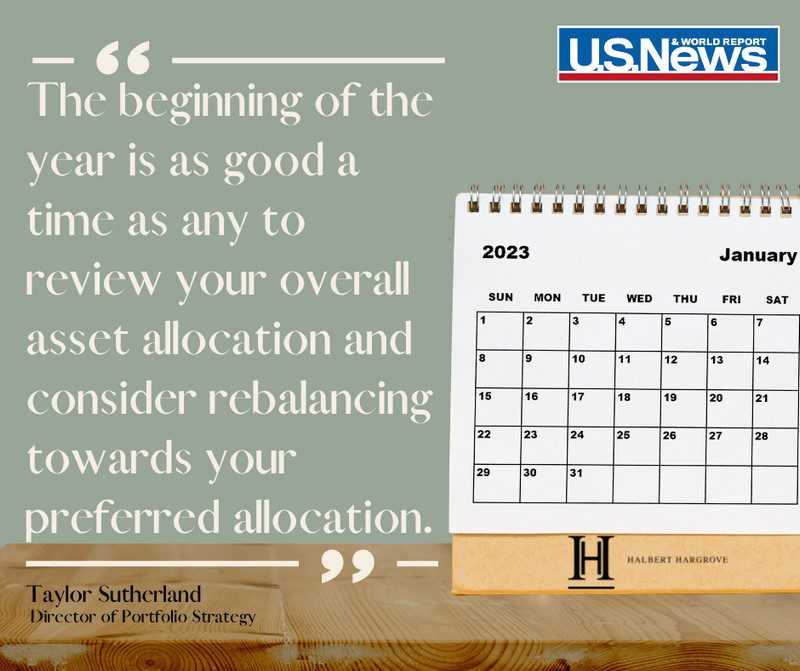By Kate Stalter, US News & World Report featuring Taylor H. Sutherland, CFP®, CIMA® AIF®, Director of Portfolio Strategy/Senior Wealth Advisor at Halbert Hargrove
Advisors have various approaches to rebalancing, and not all are calendar-based.
A new year offers an opportunity to reevaluate financial goals and strategies. A fresh look at your portfolio may result in a decision to rebalance or realign the allocations within your portfolio.
That means selling investments that have appreciated beyond your predetermined allocations and redeploying the proceeds into those that have not done as well.
As a hypothetical example, say your financial plan shows that you need to own 60% equities and 40% bonds to reach your goal of retirement in 10 years. At the end of the year, the value of your stocks increased by 10%, while the value of your bonds decreased by the same amount. Your allocation now stands at 70% stocks and 30% bonds.
To get that back in line, you’d sell enough stocks to get your allocation back to 60% and reinvest that money into your bonds so you are back to 40% on that side.
Here’s a look at some strategies for how to rebalance your portfolio for 2023:
- How often should you rebalance your portfolio?
- Look at the big picture.
- Rebalancing strategies.
- Portfolio management for 2023.
How Often Should You Rebalance Your Portfolio?
Some asset managers advocate rebalancing as needed; others recommend yearly or quarterly. While there are quarters and even years when not much change is needed, it’s not a bad idea to check your allocations on a regular basis.
“The beginning of the year is as good a time as any to review your overall asset allocation and consider rebalancing towards your preferred allocation,” says Taylor Sutherland, senior wealth advisor at Halbert Hargrove.
He notes that given material declines in both stocks and bonds in 2022, portfolios may not be too far out of whack. He offers some practical steps for approaching the rebalancing process.
“Preferably you do this each year, which would’ve meant trimming a presumably overweight stock portfolio at the beginning of 2022,” he says. “Bottom line: Set limits for how far you’ll let your portfolio drift in terms of your preferred allocation. When it exceeds those levels, rebalance.”
Look At the Big Picture
Heather Comella, a certified financial planner and planning success lead at Origin, says a disciplined approach to rebalancing uses historical data to create limits and triggers to show when a portfolio has drifted.
The process of rebalancing, she says, “allows the investor to remove themselves emotionally from what is going on in the markets and avoid the temptation of trying to time your trades. Preset tolerance bands may trigger a need to rebalance a portfolio, but this is just one piece of the analysis required for rebalancing investments.”
She points out that a holistic approach to portfolio management involves an investor’s total financial picture. For example, taxes, trading fees, cash needs and expected cash deposits are factors that can affect a decision to rebalance.
Comella adds that the correlation between stocks and bonds in 2022 means the impact on a diversified stock-and-bond portfolio may look different than in previous times of market volatility. For example, rather than rebalancing the broad equity asset class, investors and their advisors may focus on sub-asset classes, such as small-cap stocks or international stocks.
She adds that investors can also focus on tax-loss harvesting, which involves selling securities with losses to offset gains in other areas. Those investment losses, while not directly offsetting some other taxes, such as those on earned income, should be viewed as part of an investor’s total tax situation.


